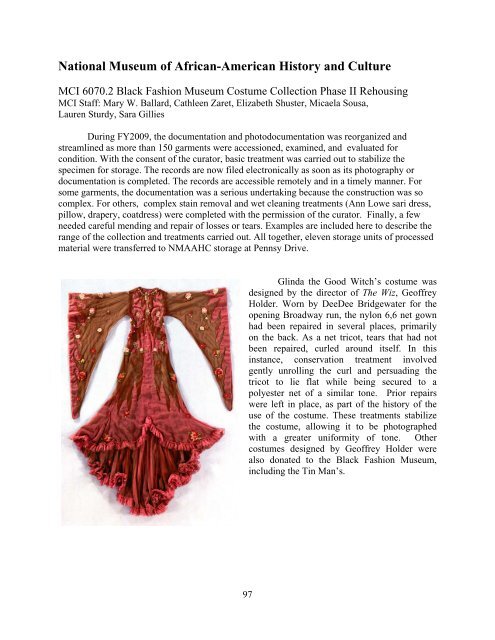MCI Project Summaries 2008 - Smithsonian Institution
MCI Project Summaries 2008 - Smithsonian Institution
MCI Project Summaries 2008 - Smithsonian Institution
You also want an ePaper? Increase the reach of your titles
YUMPU automatically turns print PDFs into web optimized ePapers that Google loves.
National Museum of African-American History and Culture<br />
<strong>MCI</strong> 6070.2 Black Fashion Museum Costume Collection Phase II Rehousing<br />
<strong>MCI</strong> Staff: Mary W. Ballard, Cathleen Zaret, Elizabeth Shuster, Micaela Sousa,<br />
Lauren Sturdy, Sara Gillies<br />
During FY2009, the documentation and photodocumentation was reorganized and<br />
streamlined as more than 150 garments were accessioned, examined, and evaluated for<br />
condition. With the consent of the curator, basic treatment was carried out to stabilize the<br />
specimen for storage. The records are now filed electronically as soon as its photography or<br />
documentation is completed. The records are accessible remotely and in a timely manner. For<br />
some garments, the documentation was a serious undertaking because the construction was so<br />
complex. For others, complex stain removal and wet cleaning treatments (Ann Lowe sari dress,<br />
pillow, drapery, coatdress) were completed with the permission of the curator. Finally, a few<br />
needed careful mending and repair of losses or tears. Examples are included here to describe the<br />
range of the collection and treatments carried out. All together, eleven storage units of processed<br />
material were transferred to NMAAHC storage at Pennsy Drive.<br />
Glinda the Good Witch’s costume was<br />
designed by the director of The Wiz, Geoffrey<br />
Holder. Worn by DeeDee Bridgewater for the<br />
opening Broadway run, the nylon 6,6 net gown<br />
had been repaired in several places, primarily<br />
on the back. As a net tricot, tears that had not<br />
been repaired, curled around itself. In this<br />
instance, conservation treatment involved<br />
gently unrolling the curl and persuading the<br />
tricot to lie flat while being secured to a<br />
polyester net of a similar tone. Prior repairs<br />
were left in place, as part of the history of the<br />
use of the costume. These treatments stabilize<br />
the costume, allowing it to be photographed<br />
with a greater uniformity of tone. Other<br />
costumes designed by Geoffrey Holder were<br />
also donated to the Black Fashion Museum,<br />
including the Tin Man’s.<br />
97

















